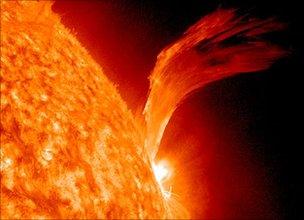Solar flares on dwarf stars could threaten alien life
- Published

The largest flares unlock streams of particles that could play havoc with planetary atmospheres
Red dwarf stars have surprisingly frequent flare-ups, scientists say, and these solar flares' effects could be deadly to life on nearby planets.
The largest flares unleash streams of particles that could play havoc with planets' atmospheres - or inhabitants.
A study of 200,000 red dwarfs - the most common type of star in our galaxy - turned up many flares of all sizes.
Scientists at the American Astronomical Society meeting said that could pose a risk to any life orbiting dwarfs.
The result is particularly relevant given the recent discovery that the Universe hosts three times as many red dwarf stars than previously thought, external.
So while the number of exoplanets is rising rapidly, with an implicit hope to find planets with conditions suitable for life, many questions remain about the very long-term habitability that the Earth has enjoyed.
Small danger
Solar flares unleash bright flashes of light of almost every colour, along with streams of charged particles.
High-energy protons from a flare, for example, can react with atmospheres to destroy ozone, making a planet that had an atmosphere susceptible to strong ultraviolet rays that are known to damage DNA.
"[A large flare] can have drastic and long-lasting effects on a surrounding planet's atmosphere," Adam Kowalski, the University of Washington astronomer presenting the results, told BBC News.
"You want to understand how often these large flares happen: once a month, a year a millennium?"
To that end, Mr Kowalski and his colleagues pored through data from the Hubble Space Telescope, studying a small region of sky 250 times over the course of seven nights.
The region, toward the centre of the galaxy, contains over 200,000 stars.
During that short time, the team saw over 100 high-energy flares, some of enormous intensity, changing the brightness of the star briefly by as much as 10%.
Geoff Marcy, an exoplanet expert from the University of California, Berkeley, said that was an exceptional increase.
"Such powerful flares bode ill for any possible biology, life, on any planet that happens to be close to that flaring star."
"It's extraordinary to think that the most numerous stars, the smallest ones in our galaxy, pose this threat to life."